(完整word版)英语中所有修辞手法的解释和例句
- 格式:doc
- 大小:47.01 KB
- 文档页数:5
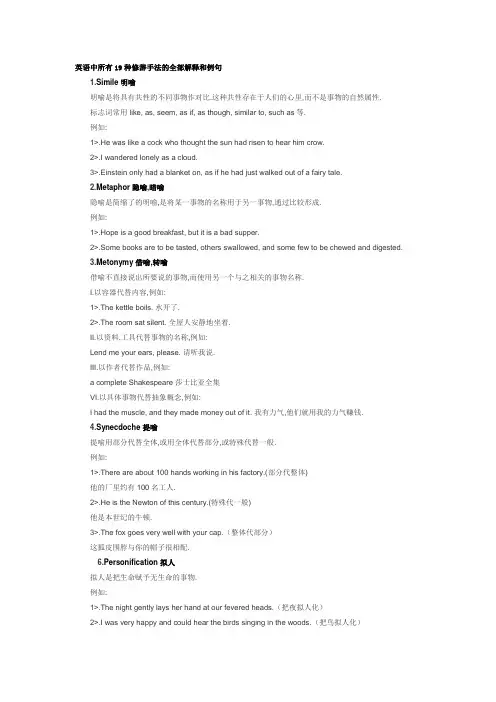
英语中所有19种修辞手法的全部解释和例句1.Simile 明喻明喻是将具有共性的不同事物作对比.这种共性存在于人们的心里,而不是事物的自然属性.标志词常用 like, as, seem, as if, as though, similar to, such as等.例如:1>.He was like a cock who thought the sun had risen to hear him crow.2>.I wandered lonely as a cloud.3>.Einstein only had a blanket on, as if he had just walked out of a fairy tale.2.Metaphor 隐喻,暗喻隐喻是简缩了的明喻,是将某一事物的名称用于另一事物,通过比较形成.例如:1>.Hope is a good breakfast, but it is a bad supper.2>.Some books are to be tasted, others swallowed, and some few to be chewed and digested.3.Metonymy 借喻,转喻借喻不直接说出所要说的事物,而使用另一个与之相关的事物名称.I.以容器代替内容,例如:1>.The kettle boils. 水开了.2>.The room sat silent. 全屋人安静地坐着.II.以资料.工具代替事物的名称,例如:Lend me your ears, please. 请听我说.III.以作者代替作品,例如:a complete Shakespeare 莎士比亚全集VI.以具体事物代替抽象概念,例如:I had the muscle, and they made money out of it. 我有力气,他们就用我的力气赚钱.4.Synecdoche 提喻提喻用部分代替全体,或用全体代替部分,或特殊代替一般.例如:1>.There are about 100 hands working in his factory.(部分代整体)他的厂里约有100名工人.2>.He is the Newton of this century.(特殊代一般)他是本世纪的牛顿.3>.The fox goes very well with your cap.(整体代部分)这狐皮围脖与你的帽子很相配.6.Personification 拟人拟人是把生命赋予无生命的事物.例如:1>.The night gently lays her hand at our fevered heads.(把夜拟人化)2>.I was very happy and could hear the birds singing in the woods.(把鸟拟人化)7.Hyperbole 夸张夸张是以言过其实的说法表达强调的目的.它可以加强语势,增加表达效果..例如:1>.I beg a thousand pardons.2>.Love you. You are the whole world to me, and the moon and the stars.3>.When she heard the bad news, a river of tears poured out.9.Euphemism 委婉,婉辞法婉辞法指用委婉,文雅的方法表达粗恶,避讳的话.例如:1>.He is out visiting the necessary. 他出去方便一下.2>.His relation with his wife has not been fortunate. 他与妻子关系不融洽.3>.Deng Xiaoping passed away in 1997. (去世)11.Irony 反语反语指用相反意义的词来表达意思的作文方式.如在指责过失.错误时,用赞同过失的说法,而在表扬时,则近乎责难的说法.例如:1>.It would be a fine thing indeed not knowing what time it was in the morning.早上没有时间观念还真是一件好事啊(真实含义是应该明确早上的时间观念)2>"Of course, you only carry large notes, no small change on you. "the waiter said to the beggar.12.Pun 双关双关就是用一个词在句子中的双重含义,借题发挥.作出多种解释,旁敲侧击,从而达到意想不到的幽默.滑稽效果.它主要以相似的词形.词意和谐音的方式出现.例如:1>.She is too low for a high praise, too brown for a fair praise and too little for a great praise.2>.An ambassador is an honest man who lies abroad for the good of his country.3>.If we don't hang together, we shall hang separately.13.Parody 仿拟这是一种模仿名言.警句.谚语,改动其中部分词语,从而使其产生新意的修辞.例如:1>.Rome was not built in a day, nor in a year.2>.A friend in need is a friend to be avoided.3>.If you give a girl an inch nowadays she will make address of it.15.Antithesis 对照,对比,对偶这种修辞指将意义完全相反的语句排在一起对比的一种修辞方法.例如:1>.Not that I loved Caeser less but that I loved Romemore.2>.You are staying; I am going.3>.Give me liberty, or give me death.17.Oxymoron 反意法,逆喻这也是一种矛盾修辞法,用两种不相调和的特征形容一个事物,以不协调的搭配使读者领悟句中微妙的含义.例如:1>.No light, but rather darkness visible.没有光亮,黑暗却清晰可见2>.The state of this house is cheerless welcome.Transferred Epithet: (移就) It is a figure of speech where an epithet (an adjective ordescriptive phrase) is transferred from the noun it should rightly modify(修饰) to another to which itdoes not really apply or belong. For instance, I spent sleepless nights on my project.1. Rushing thongs, blinded by the darkness and smoke, rushed up on a street and down the next trampling the fallen in a crazy fruitless dash toward safety.(Robert Silverbury: Pompeii)在黑暗和浓烟中狂奔的人群,沿着大街小巷踏着倒下的躯体,慌乱而徒劳地向安全地方冲闯。
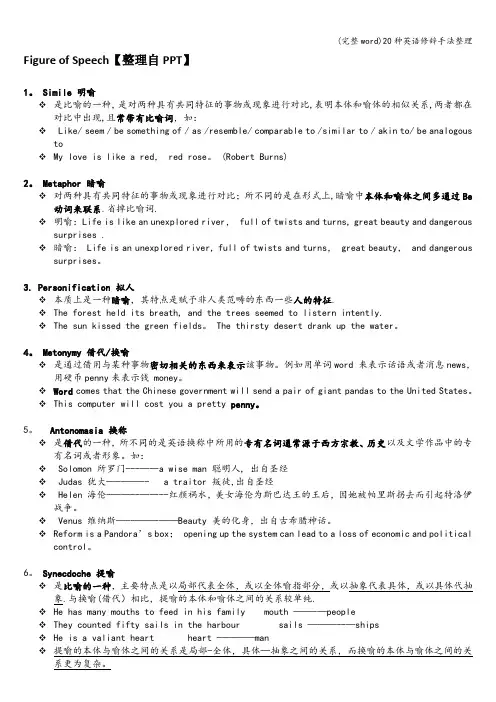
Figure of Speech【整理自PPT】1。
Simile 明喻❖是比喻的一种,是对两种具有共同特征的事物或现象进行对比,表明本体和喻体的相似关系,两者都在对比中出现,且常带有比喻词,如:❖ Like/ seem / be something of / as /resemble/ comparable to /similar to / akin to/ be analogous to❖My love is like a red, red rose。
(Robert Burns)2。
Metaphor 暗喻❖对两种具有共同特征的事物或现象进行对比;所不同的是在形式上,暗喻中本体和喻体之间多通过Be 动词来联系.省掉比喻词.❖明喻:Life is like an unexplored river, full of twists and turns, great beauty and dangerous surprises .❖暗喻: Life is an unexplored river, full of twists and turns, great beauty, and dangerous surprises。
3. Personification 拟人❖本质上是一种暗喻,其特点是赋予非人类范畴的东西一些人的特征.❖The forest held its breath, and the trees seemed to listern intently.❖The sun kissed the green fields。
The thirsty desert drank up the water。
4。
Metonymy 借代/换喻❖是通过借用与某种事物密切相关的东西来表示该事物。
例如用单词word 来表示话语或者消息news,用硬币penny来表示钱 money。
❖Word comes that the Chinese government will send a pair of giant pandas to the United States。

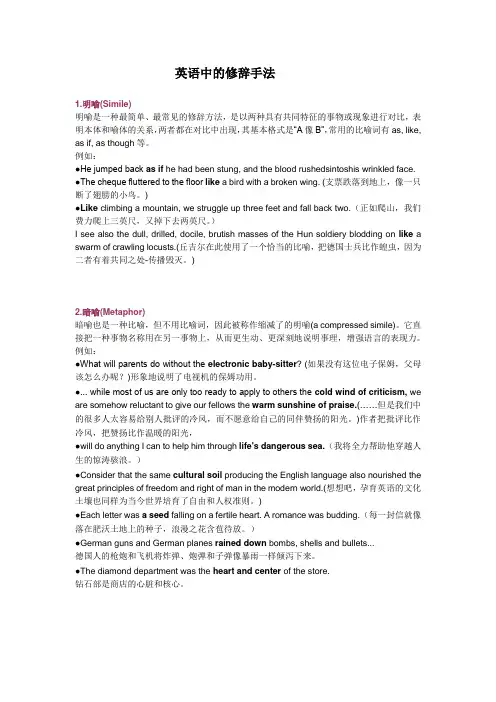
英语中的修辞手法1.明喻(Simile)明喻是一种最简单、最常见的修辞方法,是以两种具有共同特征的事物或现象进行对比,表明本体和喻体的关系,两者都在对比中出现,其基本格式是“A像B”,常用的比喻词有as, like, as if, as though等。
例如:●He jumped back as if he had been stung, and the blood rushedsintoshis wrinkled face.●The cheque fluttered to the floor like a bird with a broken wing. (支票跌落到地上,像一只断了翅膀的小鸟。
)●Like climbing a mountain, we struggle up three feet and fall back two.(正如爬山,我们费力爬上三英尺,又掉下去两英尺。
)I see also the dull, drilled, docile, brutish masses of the Hun soldiery blodding on like a swarm of crawling locusts.(丘吉尔在此使用了一个恰当的比喻,把德国士兵比作蝗虫,因为二者有着共同之处-传播毁灭。
)2.暗喻(Metaphor)暗喻也是一种比喻,但不用比喻词,因此被称作缩减了的明喻(a compressed simile)。
它直接把一种事物名称用在另一事物上,从而更生动、更深刻地说明事理,增强语言的表现力。
例如:●What will parents do without the electronic baby-sitter? (如果没有这位电子保姆,父母该怎么办呢?)形象地说明了电视机的保姆功用。
●... while most of us are only too ready to apply to others the cold wind of criticism, we are somehow reluctant to give our fellows the warm sunshine of praise.(……但是我们中的很多人太容易给别人批评的冷风,而不愿意给自己的同伴赞扬的阳光。
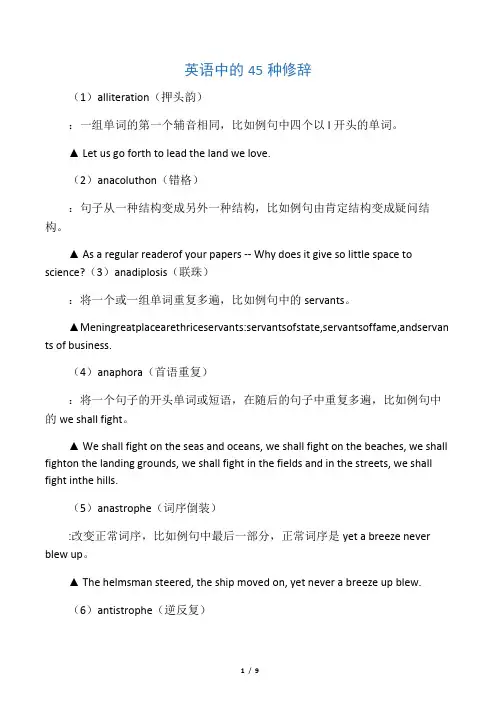
英语中的45种修辞(1)alliteration(押头韵):一组单词的第一个辅音相同,比如例句中四个以l开头的单词。
▲ Let us go forth to lead the land we love.(2)anacoluthon(错格):句子从一种结构变成另外一种结构,比如例句由肯定结构变成疑问结构。
▲ As a regular readerof your papers -- Why does it give so little space to science?(3)anadiplosis(联珠):将一个或一组单词重复多遍,比如例句中的servants。
▲Meningreatplacearethriceservants:servantsofstate,servantsoffame,andservan ts of business.(4)anaphora(首语重复):将一个句子的开头单词或短语,在随后的句子中重复多遍,比如例句中的we shall fight。
▲ We shall fight on the seas and oceans, we shall fight on the beaches, we shall fighton the landing grounds, we shall fight in the fields and in the streets, we shall fight inthe hills.(5)anastrophe(词序倒装):改变正常词序,比如例句中最后一部分,正常词序是yet a breeze never blew up。
▲ The helmsman steered, the ship moved on, yet never a breeze up blew.(6)antistrophe(逆反复):在每个句子的结尾,重复相同的单词或短语,比如例句中的without warning。
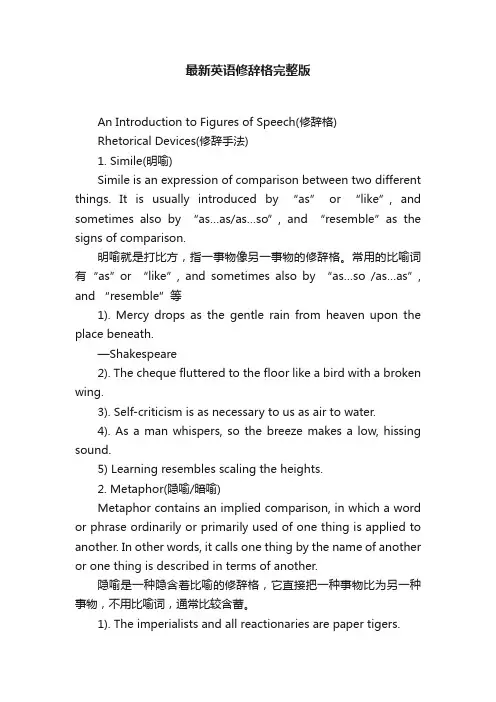
最新英语修辞格完整版An Introduction to Figures of Speech(修辞格)Rhetorical Devices(修辞手法)1. Simile(明喻)Simile is an expression of comparison between two different things. It is usually introduced by “as” or “like”, and sometimes also by “as…as/as…so”, and “resemble”as the signs of comparison.明喻就是打比方,指一事物像另一事物的修辞格。
常用的比喻词有“as”or “like”, and sometimes also by “as…so /as…as”, and “resemble”等1). Mercy drops as the gentle rain from heaven upon the place beneath.—Shakespeare2). The cheque fluttered to the floor like a bird with a broken wing.3). Self-criticism is as necessary to us as air to water.4). As a man whispers, so the breeze makes a low, hissing sound.5) Learning resembles scaling the heights.2. Metaphor(隐喻/暗喻)Metaphor contains an implied comparison, in which a word or phrase ordinarily or primarily used of one thing is applied to another. In other words, it calls one thing by the name of another or one thing is described in terms of another.隐喻是一种隐含着比喻的修辞格,它直接把一种事物比为另一种事物,不用比喻词,通常比较含蓄。
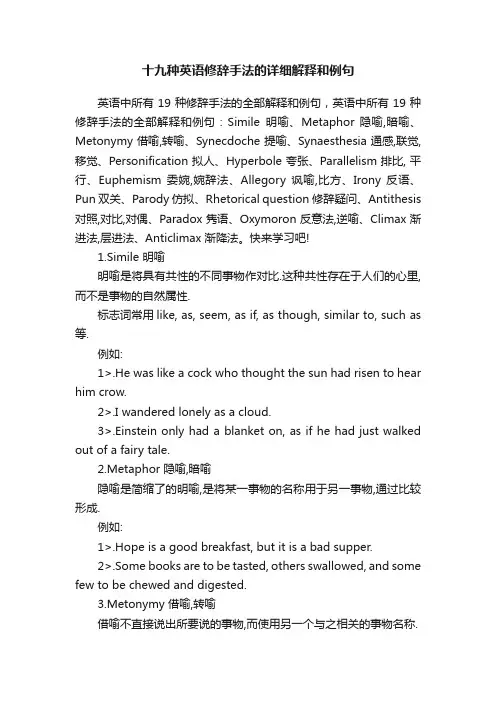
十九种英语修辞手法的详细解释和例句英语中所有19种修辞手法的全部解释和例句,英语中所有19种修辞手法的全部解释和例句:Simile明喻、Metaphor 隐喻,暗喻、Metonymy 借喻,转喻、Synecdoche 提喻、Synaesthesia 通感,联觉,移觉、Personification 拟人、Hyperbole 夸张、Parallelism 排比, 平行、Euphemism 委婉,婉辞法、Allegory 讽喻,比方、Irony 反语、Pun 双关、Parody 仿拟、Rhetorical question 修辞疑问、Antithesis 对照,对比,对偶、Paradox 隽语、Oxymoron 反意法,逆喻、Climax 渐进法,层进法、Anticlimax 渐降法。
快来学习吧!1.Simile 明喻明喻是将具有共性的不同事物作对比.这种共性存在于人们的心里,而不是事物的自然属性.标志词常用like, as, seem, as if, as though, similar to, such as 等.例如:1>.He was like a cock who thought the sun had risen to hear him crow.2>.I wandered lonely as a cloud.3>.Einstein only had a blanket on, as if he had just walked out of a fairy tale.2.Metaphor 隐喻,暗喻隐喻是简缩了的明喻,是将某一事物的名称用于另一事物,通过比较形成.例如:1>.Hope is a good breakfast, but it is a bad supper.2>.Some books are to be tasted, others swallowed, and some few to be chewed and digested.3.Metonymy 借喻,转喻借喻不直接说出所要说的事物,而使用另一个与之相关的事物名称.I.以容器代替内容,例如:1>.The kettle boils. 水开了.2>.The room sat silent. 全屋人安静地坐着.II.以资料.工具代替事物的名称,例如:Lend me your ears, please. 请听我说.III.以作者代替作品,例如:a complete Shakespeare 莎士比亚全集VI.以具体事物代替抽象概念,例如:I had the muscle, and they made money out of it. 我有力气,他们就用我的力气赚钱.4.Synecdoche 提喻提喻用部分代替全体,或用全体代替部分,或特殊代替一般.例如:1>.There are about 100 hands working in his factory.(部分代整体)他的厂里约有100名工人.2>.He is the Newton of this century.(特殊代一般)他是本世纪的牛顿.3>.The fox goes very well with your cap.(整体代部分)这狐皮围脖与你的帽子很相配.5.Synaesthesia 通感,联觉,移觉这种修辞法是以视.听.触.嗅.味等感觉直接描写事物.通感就是把不同感官的感觉沟通起来,借联想引起感觉转移,“以感觉写感觉”。
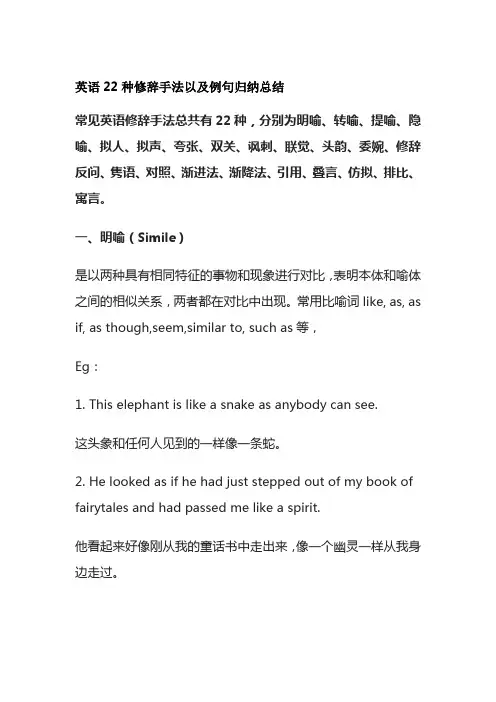
英语22种修辞手法以及例句归纳总结常见英语修辞手法总共有22种,分别为明喻、转喻、提喻、隐喻、拟人、拟声、夸张、双关、讽刺、联觉、头韵、委婉、修辞反问、隽语、对照、渐进法、渐降法、引用、叠言、仿拟、排比、寓言。
一、明喻(Simile)是以两种具有相同特征的事物和现象进行对比,表明本体和喻体之间的相似关系,两者都在对比中出现。
常用比喻词like, as, as if, as though,seem,similar to, such as等,Eg:1. This elephant is like a snake as anybody can see.这头象和任何人见到的一样像一条蛇。
2. He looked as if he had just stepped out of my book of fairytales and had passed me like a spirit.他看起来好像刚从我的童话书中走出来,像一个幽灵一样从我身边走过。
3. It has long leaves that sway in the wind like slim fingers reaching to touch something.它那长长的叶子在风中摆动,好像伸出纤细的手指去触摸什么东西似的。
二、隐喻(Metaphor)这种比喻不通过比喻词进行,而是直接将用事物当作乙事物来描写,甲乙两事物之间的联系和相似之处是暗含的。
Eg:1、The diamond department was the heart and center of the store.钻石部是商店的心脏和核心。
2. He is a pig.他简直是头猪。
(比喻:他是一个像猪一般的人,指肮脏,贪吃的人。
)3. She is a woman with a stony heart.她是一个铁石心肠的女人。
(比喻:这个女人冷酷无情。
)4.Mark Twain is a mirror of America.马克•吐温是美国的一面镜子。
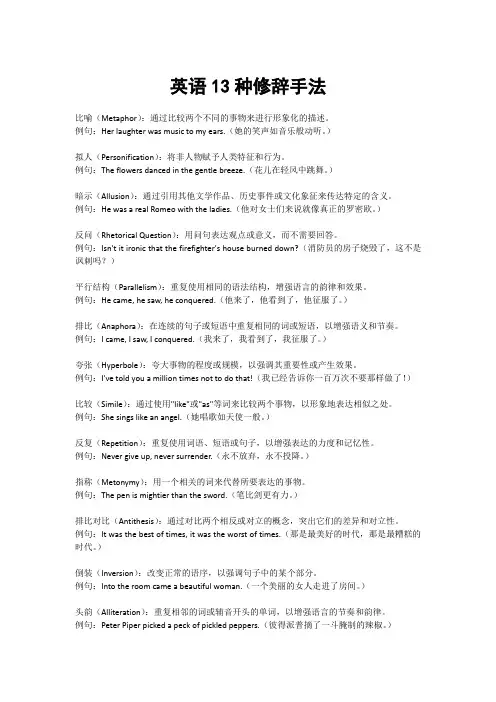
英语13种修辞手法比喻(Metaphor):通过比较两个不同的事物来进行形象化的描述。
例句:Her laughter was music to my ears.(她的笑声如音乐般动听。
)拟人(Personification):将非人物赋予人类特征和行为。
例句:The flowers danced in the gentle breeze.(花儿在轻风中跳舞。
)暗示(Allusion):通过引用其他文学作品、历史事件或文化象征来传达特定的含义。
例句:He was a real Romeo with the ladies.(他对女士们来说就像真正的罗密欧。
)反问(Rhetorical Question):用问句表达观点或意义,而不需要回答。
例句:Isn't it ironic that the firefighter's house burned down?(消防员的房子烧毁了,这不是讽刺吗?)平行结构(Parallelism):重复使用相同的语法结构,增强语言的韵律和效果。
例句:He came, he saw, he conquered.(他来了,他看到了,他征服了。
)排比(Anaphora):在连续的句子或短语中重复相同的词或短语,以增强语义和节奏。
例句:I came, I saw, I conquered.(我来了,我看到了,我征服了。
)夸张(Hyperbole):夸大事物的程度或规模,以强调其重要性或产生效果。
例句:I've told you a million times not to do that!(我已经告诉你一百万次不要那样做了!)比较(Simile):通过使用"like"或"as"等词来比较两个事物,以形象地表达相似之处。
例句:She sings like an angel.(她唱歌如天使一般。
)反复(Repetition):重复使用词语、短语或句子,以增强表达的力度和记忆性。
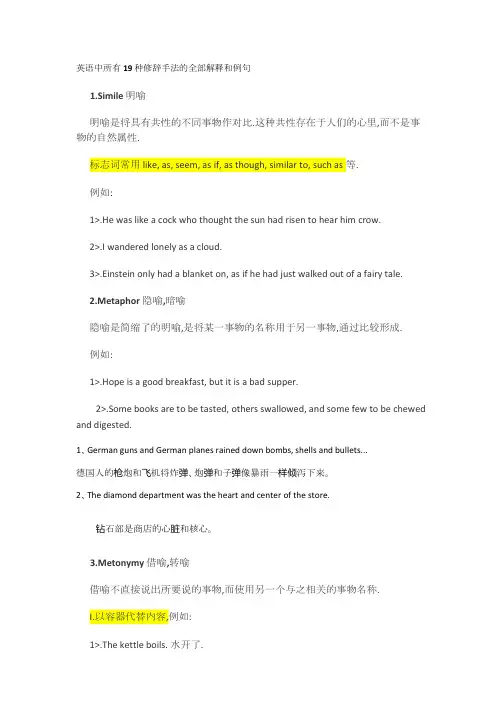
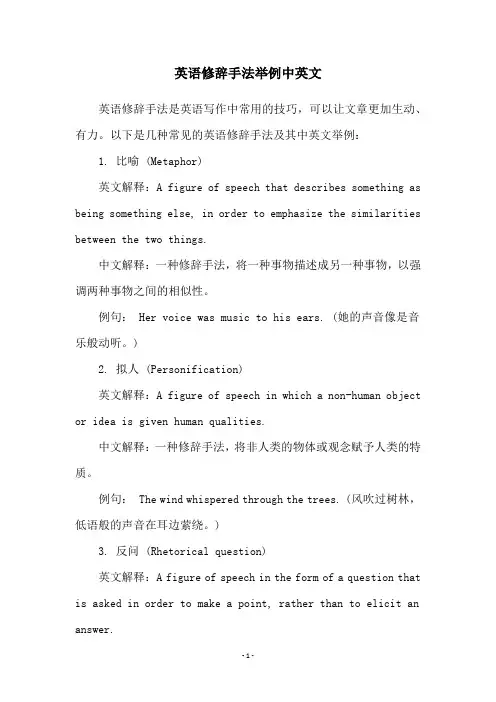
英语修辞手法举例中英文英语修辞手法是英语写作中常用的技巧,可以让文章更加生动、有力。
以下是几种常见的英语修辞手法及其中英文举例:1. 比喻 (Metaphor)英文解释:A figure of speech that describes something as being something else, in order to emphasize the similarities between the two things.中文解释:一种修辞手法,将一种事物描述成另一种事物,以强调两种事物之间的相似性。
例句: Her voice was music to his ears. (她的声音像是音乐般动听。
)2. 拟人 (Personification)英文解释:A figure of speech in which a non-human object or idea is given human qualities.中文解释:一种修辞手法,将非人类的物体或观念赋予人类的特质。
例句: The wind whispered through the trees. (风吹过树林,低语般的声音在耳边萦绕。
)3. 反问 (Rhetorical question)英文解释:A figure of speech in the form of a question that is asked in order to make a point, rather than to elicit an answer.中文解释:一种修辞手法,以问句的形式表达观点,而不是期望得到回答。
例句: Would you jump off a bridge just because your friends did? (你会因为朋友跳桥而跟随吗?)4. 排比 (Parallelism)英文解释:The use of similar grammatical structures, phrases or words to create a rhythmic and balanced effect.中文解释:一种修辞手法,使用相似的语法结构、短语或单词,以创造节奏感和平衡效果。
英语的19种修辞手法英语中所有19种修辞手法的全部解释和例句:Simile明喻、Metaphor 隐喻,暗喻、Metonymy 借喻,转喻、Synecdoche 提喻、Synaesthesia 通感,联觉,移觉、Personification 拟人、Hyperbole 夸张、Parallelism 排比, 平行、Euphemism 委婉,婉辞法、Allegory 讽喻,比方、Irony 反语、Pun 双关、Parody 仿拟、Rhetorical question 修辞疑问、Antithesis 对照,对比,对偶、Paradox 隽语、Oxymoron 反意法,逆喻、Climax 渐进法,层进法、Anticlimax 渐降法。
快来学习吧!1.Simile 明喻明喻是将具有共性的不同事物作对比.这种共性存在于人们的心里,而不是事物的自然属性.标志词常用 like, as, seem, as if, as though, similar to, such as等.例如:1>.He was like a cock who thought the sun had risen to hear him crow.2>.I wandered lonely as a cloud.3>.Einstein only had a blanket on, as if he had just walked out of a fairy tale.2.Metaphor 隐喻,暗喻隐喻是简缩了的明喻,是将某一事物的名称用于另一事物,通过比较形成.例如:1>.Hope is a good breakfast, but it is a bad supper.2>.Some books are to be tasted, others swallowed, and some few to be chewed and digested.3.Metonymy 借喻,转喻借喻不直接说出所要说的事物,而使用另一个与之相关的事物名称.I.以容器代替内容,例如:1>.The kettle boils. 水开了.2>.The room sat silent. 全屋人安静地坐着.II.以资料.工具代替事物的名称,例如:Lend me your ears, please. 请听我说.III.以作者代替作品,例如:a complete Shakespeare 莎士比亚全集VI.以具体事物代替抽象概念,例如:I had the muscle, and they made money out of it. 我有力气,他们就用我的力气赚钱.4.Synecdoche 提喻提喻用部分代替全体,或用全体代替部分,或特殊代替一般.例如:1>.There are about 100 hands working in his factory.(部分代整体)他的厂里约有100名工人.2>.He is the Newton of this century.(特殊代一般)他是本世纪的牛顿.3>.The fox goes very well with your cap.(整体代部分)这狐皮围脖与你的帽子很相配.5.Synaesthesia 通感,联觉,移觉这种修辞法是以视.听.触.嗅.味等感觉直接描写事物.通感就是把不同感官的感觉沟通起来,借联想引起感觉转移,“以感觉写感觉”。
英语修辞手法及例句一、明喻simile是以两种具有相同特征的事物和现象进行对比;表明本体和喻体之间的相似关系;两者都在对比中出现..常用比喻词like; as; as if; as though等;例如:1、This elephant is like a snake as anybody can see.这头象和任何人见到的一样像一条蛇..2、He looked as if he had just stepped out of my book of fairytales and had passed me like a spirit.他看上去好像刚从我的童话故事书中走出来;像幽灵一样从我身旁走过去..3、It has long leaves that sway in the wind like slim fingers reaching to touch something.它那长长的叶子在风中摆动;好像伸出纤细的手指去触摸什么东西似的..二、隐喻metaphor这种比喻不通过比喻词进行;而是直接将用事物当作乙事物来描写;甲乙两事物之间的联系和相似之处是暗含的..1、The diamond department was the heart and center of the store. 钻石部是商店的心脏和核心..2.He is a pig.他简直是头猪..比喻:他是一个像猪一般的人;指肮脏;贪吃的人..3.She is a woman with a stony heart.她是一个铁石心肠的女人..比喻:这个女人冷酷无情..3.Mark Twain is a mirror of America.马克吐温是美国的一面镜子..用镜子比喻美国的现实;很贴切..三、提喻synecdoche提喻是不直接说某一事物的名称;而是借事物的本身所呈现的各种对应的现象来表现该事物的这样一种修辞手段..换喻主要借助于密切的关系与联想;而提喻则是借助于部分相似..提喻大致归纳为四种情况:a.部分和全体互代;b.以材料代替事物;c.抽象和具体互代;d.以个体代替整个类..例如:1.Outside;there is a sea of faces.外面街上;是人的海洋..以人体的局部代全体;即以faces 表示people2. Have you any coppers 你有钱吗以材料代事物;即以copper铜喻指coin money铜币3.They share the same roof.他们住在一起..以部分代全体;即用roof屋顶;表示house屋子、住宅4.He is the Newton of this century.他是本世纪的牛顿..以个体代整个类;用Newton表示scientist科学家5.It was reported that China won the volleyball match.椐报载:在这次排球赛中;中国队赢了..以国家名称China代该国球队the Chinese Volleyball Team6.Life was a wearing to him.生活令他感到厌倦..以抽象代具体;即用wearing喻指a wearing thing令人厌倦的事情7、“...saying that it was the most beautiful tongue in the world;...”……他说这是世界上最美的语言..这里用具体的“tongue”代替抽象的“language”..四、拟人personification这种修辞方法是把人类的特点、特性加于外界事物之上;使之人格化;以物拟人;以达到彼此交融;合二为一..My only worry was that January would find me hunting for a job again. 我唯一担心的是;到了一月份我又得去找工作..英语里常把“年”“月”“日”人格化;赋以生命;使人们读起来亲切生动..五、夸张hyperbole这是运用丰富的想象;过激的言词;渲染和装饰客观事物;以达到强调的效果..1、My blood froze.我的血液都凝固了..2、When I told our father about this; his heart burst.当我将这件事告诉我们的父亲时;他的心几乎要迸出来..3、My heart almost stopped beating when I heard my daughter’s voice on the phone.从电话里一听到我女儿的声音;我的心几乎停止跳动..六、叠言rhetorical repetition这种修辞法是指在特定的语境中;将相同的结构;相同意义词组成句子重叠使用;以增强语气和力量..1、It must be created by the blood and the work of all of us who believe in the future; who believe in man and his glorious man—made destiny.它必须用我们这些对于未来;对于人类以及人类自己创造的伟大命运具有信心的人的鲜血和汗水去创造..2、... Because good technique in medicine and surgery means more quickly—cured patients; less pain; less discomfort; less death; less disease and less deformity.因为优良的医疗技术和外科手术意味着更快地治疗病人;更少痛苦;更少不安;更少死亡;更少疾病;和更少残废..七、转喻Metonymy是指当甲事物同乙事物不相类似;但有密切关系时;可以利用这种关系;以乙事物的名称来取代甲事物;这样的一种修辞手段..转喻的重点不是在“相似”;而是在“联想”..转喻又称;或..例如:1.The kettle boils.壶水开..用the kettle壶;表示 the water in the kettle 壶水2.He is fond of the bottle.他喜欢喝酒..用bottle装酒的瓶子;表示wine酒3.Grey hairs should be respected.老人应受到尊重..用grey hairs白发;表示 old people老人4.The pen is mightier than the sword.笔要比剑更锋利..用pen 笔;表示article文章5.I am reading Lu xun.我在读鲁迅的作品..用Lu xun鲁迅;表示Lu Hsun's works鲁迅的作品八、双关语pun是以一个词或词组;用巧妙的办法同时把互不关联的两种含义结合起来;以取得一种诙谐有趣的效果..它主要以相似的词形.词意和谐音的方式出现.Napoleon was astonished.”Either you are mad; or I am;”he declared. “Both;sir”cried the Swede proudly.“Both”一词一语双关;既指拿破仑和这位士兵都是疯子;又指这位战士参加过拿破仑指挥的两次战役..九、拟声onomatopoeia是摹仿自然界中非语言的声音;其发音和所描写的事物的声音很相似;使语言显得生动;富有表现力..1、On the root of the school house some pigeons were softly cooing. 在学校房屋的屋顶上一些鸽子正轻轻地咕咕叫着..2、She brought me into touch with everything that could be reached or felt——sunlight; the rustling of silk; the noises of insects; the creaking of a door; the voice of a loved one.她使我接触到所有够得着的或者感觉得到的东西;如阳光呀;丝绸摆动时的沙沙声呀;昆虫的叫声呀;开门的吱嗄声呀;亲人的说话声呀..十、讽刺irony是指用含蓄的褒义词语来表示其反面的意义;从而达到使本义更加幽默;更加讽刺的效果..Sarcasm; satireIt would be a fine thing indeed not knowing what time it was in the morning.早上没有时间观念还真是一件好事啊真实含义是应该明确早上的时间观念Well; of course; I knew that gentlemen like you carry only large notes.啊;当然;我知道像你这样的先生只带大票子..店员这句话意在讽刺这位穿破衣的顾客:像你这样的人怎么会有大票子呢名为“gentlemen”实则“beggar”而已..十一、通感synesthesia sin s'θi: i 是指在某个感官所产生的感觉;转到另一个感官的心理感受..Taste the music of Mozart.用嗅觉形容听觉品尝Mozart的音乐.Some books are to be tasted; others to be swallowed and some few to be chewed and digested.有些书是应当尝尝滋味的;有些书是应当吞下去的;有少数书是应当咀嚼和消化的..书是“尝”不出味道的;也是不能“吃”下去将其“消化”掉的..这里把读书中的精读和泛读;阅读欣赏与吸收知识的感受;用味觉功能和消化功能来表示;心理感受是如此逼真和奇特..十二、头韵法alliteration在文句中有两个以上连结在一起的词或词组;其开头的音节有同样的字母或声音;以增强语言的节奏感..How and why he had come to Princeton; New Jersey is a story of struggle; success; and sadness.14.Euphemism 委婉;婉辞法婉辞法指用委婉;文雅的方法表达粗恶;避讳的话.例如:1>.He is out visiting the necessary 他出去方便一下.2>.His relation with his wife has not been fortunate. 他与妻子关系不融洽.3>.Deng Xiaoping passed away in 1997. 去世15.Parody 仿拟这是一种模仿名言.警句.谚语;改动其中部分词语;从而使其产生新意的修辞.例如:1>.Rome was not built in a day; nor in a year.2>.A friend in need is a friend to be avoided.16.Rhetorical question 修辞疑问反问它与疑问句的不同在于它并不以得到答复为目的;而是以疑问为手段;取得修辞上的效果;其特点是:肯定问句表示强烈否定;而否定问句表示强烈的肯定.它的答案往往是不言而喻的.例如:1>.How was it possible to walk for an hour through the woods and see nothing worth of note2>.Shall we allow those untruths to go unanswered17.Paradox 隽语这是一种貌似矛盾;但包含一定哲理的意味深长的说法;是一种矛盾修辞法..例如:1>.More haste; less speed.欲速则不达2>.The child is the father to the man.童年时代可决定人之未来三岁看大;四岁看老..18.Antithesis n't θ s s对照;对比;对偶这种修辞指将意义完全相反的语句排在一起对比的一种修辞方法.例如:1>.Not that I loved Caeser less but that I loved Romemore.2>.You are staying; I am going.3>.Give me liberty; or give me death.。
英语修辞手法总结Figures of speech (修辞)are ways of making our language figurative. When we use words in other than their ordinary or literal sense to lend force to an idea, to heighten effect, orto create suggestive imagery, we are said to be speaking or writing figuratively. Now we are going to talk about some common forms of figures of speech.1) Simile:(明喻)It is a figure of speech which makes a comparison between two unlike elements having at least one quality or characteristic (特性)in common. To make the comparison, words like as, as...as, as if and like are used to transfer the quality we associate with one to the other. For example, As cold waters to a thirsty soul, so is good news from a far country.2) Metaphor:(暗喻)It is like a simile, also makes a comparison between two unlike elements, but unlike a simile, this comparison is implied rather than stated. For example, the worldis a stage.3) Analogy: (类比)It is also a form of comparison, but unlike simile or metaphor which usually uses comparison on one point of resemblance, analogy draws a parallel between two unlike things that have several common qualities or points of resemblance.4) Personification: (拟人)It gives human form of feelings to animals, or life and personal attributes(赋予) to inanimate(无生命的) objects, or to ideas and abstractions(抽象). For example, the wind whistled through the trees.5) Hyperbole: (夸张) It is the deliberate use of overstatement or exaggeration to achieve emphasis. For instance, he almost died laughing.6) Understatement: (含蓄陈述) It is the opposite of hyperbole, or overstatement. Itachieves its effect of emphasizing a fact by deliberately(故意地) understating it,impressing the listener or the reader more by what is merely implied or left unsaid than by bare statement. For instance, It is no laughing matter.7) Euphemism: (委婉) It is the substitution of an agreeable or inoffensive(无冒犯) expression for one that may offend or suggest something unpleasant. For instance, we referto "die" as " pass away".8) Metonymy (转喻)It is a figure of speech that has to do with the substitution of the mane of one thing for that of another. For instance, the pen (words) is mightier than the sword (forces).9) Synecdoche (提喻) It is involves the substitution of the part for the whole, or thewhole for the part. For instance, they say there's bread and work for all. She was dressedin silks.10) Antonomasia (换喻)It has also to do with substitution. It is not often mentioned now, though it is still in frequent use. For example, Solomon for a wise man. Daniel for a wise and fair judge. Judas for a traitor.11) Pun: (双关语) It is a play on words, or rather a play on the form and meaning of words. For instance, a cannon-ball took off his legs, so he laid down his arms. (Here "arms" has two meanings: a person's body; weapons carried by a soldier.)12) Syllepsis: (一语双叙) It has two connotations.In the first case, it is a figure by which a word, or a particular form or inflection of a word, refers to two or more words in the same sentence, while properly applying to or agreeing with only on of them in grammar or syntax(句法). For example, He addressed you and me, and desired us to follow him. (Here us is used to refer to you and me.)In the second case, it a word may refer to two or more words in the same sentence. For example, while he was fighting , and losing limb and mind, and dying, others stayed behind to pursue education and career. (Here to losing one's limbs in literal; to lose one's mindis figurative, and means to go mad.)13) Zeugma: (轭式搭配) It is a single word which is made to modify or to govern two or more words in the same sentence, wither properly applying in sense to only one of them, or applying to them in different senses. For example, The sun shall not burn you by day, nor the moon by night. (Here noon is not strong enough to burn)14) Irony: (反语) It is a figure of speech that achieves emphasis by saying the opposite of what is meant, the intended meaning of the words being the opposite of their usual sense. For instance, we are lucky, what you said makes me feel real good.15) Innuendo: (暗讽) It is a mild form of irony, hinting in a rather roundabout (曲折)way at something disparaging(不一致) or uncomplimentary(不赞美) to the person or subject mentioned. For example, the weatherman said it would be worm. He must take his readings in a bathroom.16) Sarcasm: (讽刺) It Sarcasm is a strong form of irony. It attacks in a taunting and bitter manner, and its aim is to disparage, ridicule and wound the feelings of the subject attacked. For example, laws are like cobwebs, which may catch small flies, but let wasps break through.17) Paradox: (似非而是的隽语) It is a figure of speech consisting of a statement or proposition which on the face of it seems self-contradictory, absurd or contrary to established fact or practice, but which on further thinking and study may prove to be true, well-founded, and even to contain a succinct point. For example more haste, less speed.18) Oxymoron: (矛盾修饰) It is a compressed paradox, formed by the conjoining(结合) of two contrasting, contradictory or incongruous(不协调) terms as in bitter-sweet memories, orderly chaos(混乱) and proud humility(侮辱).19) Antithesis: (对照) It is the deliberate arrangement of contrasting words or ideas in balanced structural forms to achieve emphasis. For example, speech is silver; silence is golden.20) Epigram: (警句) It states a simple truth pithily(有利地) and pungently(强烈地). It is usually terse and arouses interest and surprise by its deep insight into certain aspects of human behavior or feeling. For instance, Few, save the poor, feel for the poor.21) Climax: (渐进) It is derived from the Greek word for "ladder" and implies the progression of thought at a uniform or almost uniform rate of significance or intensity,like the steps of a ladder ascending evenly. For example, I came, I saw, I conquered.22) Anti-climax or bathos: (突降)It is the opposite of Climax. It involves stating one's thoughts in a descending order of significance or intensity, from strong to weak, from weighty to light or frivolous. For instance, But thousands die, without or this or that, die, and endow(赋予) a college, or a cat.23) Apostrophe: (顿呼) In this figure of speech, a thing, place, idea or person (dead or absent) is addressed as if present, listening and understanding what is being said. For instance, England! awake! awake! awake!24) Transferred Epithet: (转类形容词) It is a figure of speech where an epithet (anadjective or descriptive phrase) is transferred from the noun it should rightly modify(修饰) to another to which it does not really apply or belong. For instance, I spent sleeplessnights on my project.25) Alliteration: (头韵) It has to do with the sound rather than the sense of words for effect. It is a device that repeats the same sound at frequent intervals(间隔) and since the sound repeated is usually the initial consonant sound, it is also called "front rhyme". For instance, the fair breeze blew, the white foam flew, the furrow followed free.26) Onomatopoeia: (拟声) It is a device that uses words which imitate the sounds made by an object (animate or inanimate), or which are associated with or suggestive(提示的) of some action or movementExplanation version1一、什么是修辞格修辞格(figures of speech)是提高语言表达效果的语言艺术。
英语修辞手法总结Figures of speech (修辞)are ways of making our language figurative. When we use words in other than their ordinary or literal sense to lend force to an idea, to heighten effect, orto create suggestive imagery, we are said to be speaking or writing figuratively. Now we are going to talk about some common forms of figures of speech.1) Simile:(明喻)It is a figure of speech which makes a comparison between two unlike elements having at least one quality or characteristic (特性)in common. To make the comparison, words like as, as...as, as if and like are used to transfer the quality we associate with one to the other. For example, As cold waters to a thirsty soul, so is good news from a far country.2) Metaphor:(暗喻)It is like a simile, also makes a comparison between two unlike elements, but unlike a simile, this comparison is implied rather than stated. For example, the worldis a stage.3) Analogy: (类比)It is also a form of comparison, but unlike simile or metaphor which usually uses comparison on one point of resemblance, analogy draws a parallel between two unlike things that have several common qualities or points of resemblance.4) Personification: (拟人)It gives human form of feelings to animals, or life and personal attributes(赋予) to inanimate(无生命的) objects, or to ideas and abstractions(抽象). For example, the wind whistled through the trees.5) Hyperbole: (夸张) It is the deliberate use of overstatement or exaggeration to achieve emphasis. For instance, he almost died laughing.6) Understatement: (含蓄陈述) It is the opposite of hyperbole, or overstatement. Itachieves its effect of emphasizing a fact by deliberately(故意地) understating it,impressing the listener or the reader more by what is merely implied or left unsaid than by bare statement. For instance, It is no laughing matter.7) Euphemism: (委婉) It is the substitution of an agreeable or inoffensive(无冒犯) expression for one that may offend or suggest something unpleasant. For instance, we refer to "die" as " pass away".8) Metonymy (转喻)It is a figure of speech that has to do with the substitution of the mane of one thing for that of another. For instance, the pen (words) is mightier than the sword (forces).9) Synecdoche (提喻) It is involves the substitution of the part for the whole, or thewhole for the part. For instance, they say there's bread and work for all. She was dressedin silks.10) Antonomasia (换喻)It has also to do with substitution. It is not often mentioned now, though it is still in frequent use. For example, Solomon for a wise man. Daniel for a wise and fair judge. Judas for a traitor.11) Pun: (双关语) It is a play on words, or rather a play on the form and meaning of words. For instance, a cannon-ball took off his legs, so he laid down his arms. (Here "arms" has two meanings: a person's body; weapons carried by a soldier.)12) Syllepsis: (一语双叙) It has two connotations.In the first case, it is a figure by which a word, or a particular form or inflection of a word, refers to two or more words in the same sentence, while properly applying to or agreeing with only on of them in grammar or syntax(句法). For example, He addressed you and me, and desired us to follow him. (Here us is used to refer to you and me.)In the second case, it a word may refer to two or more words in the same sentence. For example, while he was fighting , and losing limb and mind, and dying, others stayed behind to pursue education and career. (Here to losing one's limbs in literal; to lose one's mindis figurative, and means to go mad.)13) Zeugma: (轭式搭配) It is a single word which is made to modify or to govern two or more words in the same sentence, wither properly applying in sense to only one of them, orapplying to them in different senses. For example, The sun shall not burn you by day, nor the moon by night. (Here noon is not strong enough to burn)14) Irony: (反语) It is a figure of speech that achieves emphasis by saying the opposite of what is meant, the intended meaning of the words being the opposite of their usual sense. For instance, we are lucky, what you said makes me feel real good.15) Innuendo: (暗讽) It is a mild form of irony, hinting in a rather roundabout (曲折)way at something disparaging(不一致) or uncomplimentary(不赞美) to the person or subject mentioned. For example, the weatherman said it would be worm. He must take his readings in a bathroom.16) Sarcasm: (讽刺) It Sarcasm is a strong form of irony. It attacks in a taunting and bitter manner, and its aim is to disparage, ridicule and wound the feelings of the subject attacked. For example, laws are like cobwebs, which may catch small flies, but let wasps break through.17) Paradox: (似非而是的隽语) It is a figure of speech consisting of a statement or proposition which on the face of it seems self-contradictory, absurd or contrary to established fact or practice, but which on further thinking and study may prove to be true, well-founded, and even to contain a succinct point. For example more haste, less speed.18) Oxymoron: (矛盾修饰) It is a compressed paradox, formed by the conjoining(结合) of two contrasting, contradictory or incongruous(不协调) terms as in bitter-sweet memories, orderly chaos(混乱) and proud humility(侮辱).19) Antithesis: (对照) It is the deliberate arrangement of contrasting words or ideas in balanced structural forms to achieve emphasis. For example, speech is silver; silence is golden.20) Epigram: (警句) It states a simple truth pithily(有利地) and pungently(强烈地). It is usually terse and arouses interest and surprise by its deep insight into certain aspects of human behavior or feeling. For instance, Few, save the poor, feel for the poor.21) Climax: (渐进) It is derived from the Greek word for "ladder" and implies the progression of thought at a uniform or almost uniform rate of significance or intensity,like the steps of a ladder ascending evenly. For example, I came, I saw, I conquered.22) Anti-climax or bathos: (突降)It is the opposite of Climax. It involves stating one's thoughts in a descending order of significance or intensity, from strong to weak, from weighty to light or frivolous. For instance, But thousands die, without or this or that, die, and endow(赋予) a college, or a cat.23) Apostrophe: (顿呼) In this figure of speech, a thing, place, idea or person (dead or absent) is addressed as if present, listening and understanding what is being said. For instance, England! awake! awake! awake!24) Transferred Epithet: (转类形容词) It is a figure of speech where an epithet (anadjective or descriptive phrase) is transferred from the noun it should rightly modify(修饰) to another to which it does not really apply or belong. For instance, I spent sleeplessnights on my project.25) Alliteration: (头韵) It has to do with the sound rather than the sense of words for effect. It is a device that repeats the same sound at frequent intervals(间隔) and since the sound repeated is usually the initial consonant sound, it is also called "front rhyme". For instance, the fair breeze blew, the white foam flew, the furrow followed free.26) Onomatopoeia: (拟声) It is a device that uses words which imitate the sounds made by an object (animate or inanimate), or which are associated with or suggestive(提示的) of some action or movementExplanation version1一、什么是修辞格修辞格(figures of speech)是提高语言表达效果的语言艺术。
英语中所有19种修辞手法的全部解释和例句拟声onomatopoeia,头韵alliteration,半韵assonance,移就transferred epithet,圆周句periodic sentences,反复repetition,倒装inversion,延喻 extended metaphor,共轭zeugma,嘲讽 ridicule 典故allusion1.Simile 明喻明喻是将具有共性的不同事物作对比.这种共性存在于人们的心里,而不是事物的自然属性.标志词常用 like, as, seem, as if, as though, similar to, such as等.例如:1>.He was like a cock who thought the sun had risen to hear him crow.2>.I wandered lonely as a cloud.3>.Einstein only had a blanket on, as if he had just walked out of a fairy tale.2.Metaphor 隐喻,暗喻隐喻是简缩了的明喻,是将某一事物的名称用于另一事物,通过比较形成.例如:1>.Hope is a good breakfast, but it is a bad supper.2>.Some books are to be tasted, others swallowed, and some few to be chewed and digested.3.Metonymy 借喻,转喻[mɪ'tɒnɪmɪ]借喻不直接说出所要说的事物,而使用另一个与之相关的事物名称.I.以容器代替内容,例如:1>.The kettle boils. 水开了.2>.The room sat silent. 全屋人安静地坐着.II.以资料.工具代替事物的名称,例如:Lend me your ears, please. 请听我说.III.以作者代替作品,例如:a complete Shakespeare 莎士比亚全集VI.以具体事物代替抽象概念,例如:I had the muscle, and they made money out of it. 我有力气,他们就用我的力气赚钱.4.Synecdoche 提喻[sɪ'nekdəkɪ]提喻用部分代替全体,或用全体代替部分,或特殊代替一般.例如:1>.There are about 100 hands working in his factory.(部分代整体)他的厂里约有100名工人.2>.He is the Newton of this century.(特殊代一般)他是本世纪的牛顿.3>.The fox goes very well with your cap.(整体代部分)这狐皮围脖与你的帽子很相配.5.Synaesthesia 通感,联觉,移觉[,sɪnɪs'θiːzɪə]这种修辞法是以视.听.触.嗅.味等感觉直接描写事物.通感就是把不同感官的感觉沟通起来,借联想引起感觉转移,“以感觉写感觉”。
英语中所有19种修辞手法的全部解释和例句拟声onomatopoeia,头韵alliteration,半韵assonance,移就transferred epithet,圆周句periodic sentences,反复repetition,倒装inversion,延喻 extended metaphor,共轭zeugma,嘲讽 ridicule 典故allusion1.Simile 明喻明喻是将具有共性的不同事物作对比.这种共性存在于人们的心里,而不是事物的自然属性.标志词常用 like, as, seem, as if, as though, similar to, such as等.例如:1>.He was like a cock who thought the sun had risen to hear him crow.2>.I wandered lonely as a cloud.3>.Einstein only had a blanket on, as if he had just walked out of a fairy tale.2.Metaphor 隐喻,暗喻隐喻是简缩了的明喻,是将某一事物的名称用于另一事物,通过比较形成.例如:1>.Hope is a good breakfast, but it is a bad supper.2>.Some books are to be tasted, others swallowed, and some few to be chewed and digested.3.Metonymy 借喻,转喻[mɪ'tɒnɪmɪ]借喻不直接说出所要说的事物,而使用另一个与之相关的事物名称.I.以容器代替内容,例如:1>.The kettle boils. 水开了.2>.The room sat silent. 全屋人安静地坐着.II.以资料.工具代替事物的名称,例如:Lend me your ears, please. 请听我说.III.以作者代替作品,例如:a complete Shakespeare 莎士比亚全集VI.以具体事物代替抽象概念,例如:I had the muscle, and they made money out of it. 我有力气,他们就用我的力气赚钱.4.Synecdoche 提喻[sɪ'nekdəkɪ]提喻用部分代替全体,或用全体代替部分,或特殊代替一般.例如:1>.There are about 100 hands working in his factory.(部分代整体)他的厂里约有100名工人.2>.He is the Newton of this century.(特殊代一般)他是本世纪的牛顿.3>.The fox goes very well with your cap.(整体代部分)这狐皮围脖与你的帽子很相配.5.Synaesthesia 通感,联觉,移觉[,sɪnɪs'θiːzɪə]这种修辞法是以视.听.触.嗅.味等感觉直接描写事物.通感就是把不同感官的感觉沟通起来,借联想引起感觉转移,“以感觉写感觉”。
英语中所有19种修辞手法的全部解释和例句1.Simile 明喻明喻是将具有共性的不同事物作对比.这种共性存在于人们的心里,而不是事物的自然属性.标志词常用 like, as, seem, as if, as though, similar to, such as等.例如:1>.He was like a cock who thought the sun had risen to hear him crow.2>.I wandered lonely as a cloud.3>.Einstein only had a blanket on, as if he had just walked out of a fairy tale.2.Metaphor 隐喻,暗喻隐喻是简缩了的明喻,是将某一事物的名称用于另一事物,通过比较形成.例如:1>.Hope is a good breakfast, but it is a bad supper.2>.Some books are to be tasted, others swallowed, and some few to be chewed and digested.3.Metonymy 借喻,转喻借喻不直接说出所要说的事物,而使用另一个与之相关的事物名称.I.以容器代替内容,例如:1>.The kettle boils. 水开了.2>.The room sat silent. 全屋人安静地坐着.II.以资料.工具代替事物的名称,例如:Lend me your ears, please. 请听我说.III.以作者代替作品,例如:a complete Shakespeare 莎士比亚全集VI.以具体事物代替抽象概念,例如:I had the muscle, and they made money out of it. 我有力气,他们就用我的力气赚钱.4.Synecdoche 提喻提喻用部分代替全体,或用全体代替部分,或特殊代替一般.例如:1>.There are about 100 hands working in his factory.(部分代整体)他的厂里约有100名工人.2>.He is the Newton of this century.(特殊代一般)他是本世纪的牛顿.3>.The fox goes very well with your cap.(整体代部分)这狐皮围脖与你的帽子很相配.6.Personification 拟人拟人是把生命赋予无生命的事物.例如:1>.The night gently lays her hand at our fevered heads.(把夜拟人化)2>.I was very happy and could hear the birds singing in the woods.(把鸟拟人化)7.Hyperbole 夸张夸张是以言过其实的说法表达强调的目的.它可以加强语势,增加表达效果..例如:1>.I beg a thousand pardons.2>.Love you. You are the whole world to me, and the moon and the stars.3>.When she heard the bad news, a river of tears poured out.9.Euphemism 委婉,婉辞法婉辞法指用委婉,文雅的方法表达粗恶,避讳的话.例如:1>.He is out visiting the necessary. 他出去方便一下.2>.His relation with his wife has not been fortunate. 他与妻子关系不融洽.3>.Deng Xiaoping passed away in 1997. (去世)11.Irony 反语反语指用相反意义的词来表达意思的作文方式.如在指责过失.错误时,用赞同过失的说法,而在表扬时,则近乎责难的说法.例如:1>.It would be a fine thing indeed not knowing what time it was in the morning.早上没有时间观念还真是一件好事啊(真实含义是应该明确早上的时间观念)2>"Of course, you only carry large notes, no small change on you. "the waiter said to the beggar.12.Pun 双关双关就是用一个词在句子中的双重含义,借题发挥.作出多种解释,旁敲侧击,从而达到意想不到的幽默.滑稽效果.它主要以相似的词形.词意和谐音的方式出现.例如:1>.She is too low for a high praise, too brown for a fair praise and too little for a great praise.2>.An ambassador is an honest man who lies abroad for the good of his country.3>.If we don't hang together, we shall hang separately.13.Parody 仿拟这是一种模仿名言.警句.谚语,改动其中部分词语,从而使其产生新意的修辞.例如:1>.Rome was not built in a day, nor in a year.2>.A friend in need is a friend to be avoided.3>.If you give a girl an inch nowadays she will make address of it.15.Antithesis 对照,对比,对偶这种修辞指将意义完全相反的语句排在一起对比的一种修辞方法.例如:1>.Not that I loved Caeser less but that I loved Romemore.2>.You are staying; I am going.3>.Give me liberty, or give me death.17.Oxymoron 反意法,逆喻这也是一种矛盾修辞法,用两种不相调和的特征形容一个事物,以不协调的搭配使读者领悟句中微妙的含义.例如:1>.No light, but rather darkness visible.没有光亮,黑暗却清晰可见2>.The state of this house is cheerless welcome.Transferred Epithet: (移就) It is a figure of speech where an epithet (an adjective ordescriptive phrase) is transferred from the noun it should rightly modify(修饰) to another to which itdoes not really apply or belong. For instance, I spent sleepless nights on my project.1. Rushing thongs, blinded by the darkness and smoke, rushed up on a street and down the next trampling the fallen in a crazy fruitless dash toward safety.(Robert Silverbury: Pompeii)在黑暗和浓烟中狂奔的人群,沿着大街小巷踏着倒下的躯体,慌乱而徒劳地向安全地方冲闯。
crazy 在形式上是修饰dash,但在语义上是修饰throngs,表示在火山爆发时,四处奔逃时的疯狂的样子。
2. Sometimes they threw (him) bits of food, and got scant thanks; sometimes a mischievous pebble, and a shower of stones and abuses.(Gibort Highet: Diogenes and Alexander)有时他们给他丢一点吃的,却几乎听不到感谢;有时恶作剧地向他扔块卵石,却招来他一阵石块和恶骂。
修饰有生命,有感情的人行为方式的mischievous(恶作剧的)移来修饰无生命,无感情的 pebble(小鹅卵石),表达新奇,妙趣横生。
3. He flitted away down the path, his head held high, with an air of somewhat jaded jauntiness.他沿着小路快步离开了,头昂得高高的,神情虽然高傲,但却显得有几分倦意。
句中jaded 在语义上是修饰He,表示一种状态。
4. And the first tender singing of the passionate throat of a young collier, who has since drunk himself to death.(David Herbert Lawrence: Tortoise Shout)第一支男高音歌曲是由一个年轻的矿工唱的,他的嗓音高亢激昂,唱完后,他就喝得酩酊大醉了。
句中修饰throat 的 passionate 在语义是修饰young collier。
间接肯定法(Litotes)是指用反对语的否定表达肯定的正面的意义的一种修辞手段。
间接肯定法也称曲意法。
间接肯定法与夸张法恰恰相反。
夸张是讲得过分,间接肯定法则是有意轻描淡写,把话说小,常用否定的否定来表达肯定。
例如: 1.This is no small accomplishment.这可是一个不小的成就。
(用no small表示great)2.This is not at all unpleasant.这件事一点儿也不令人讨厌。
(用not at all unpleasant表示very pleasant)3.The man is no fool.那个人绝不傻。
(用no fool表示 very clever.)4.The face wasn't a bad one.面孔长得不算坏。